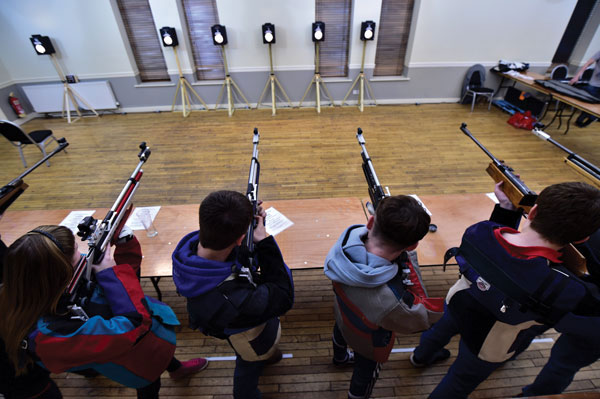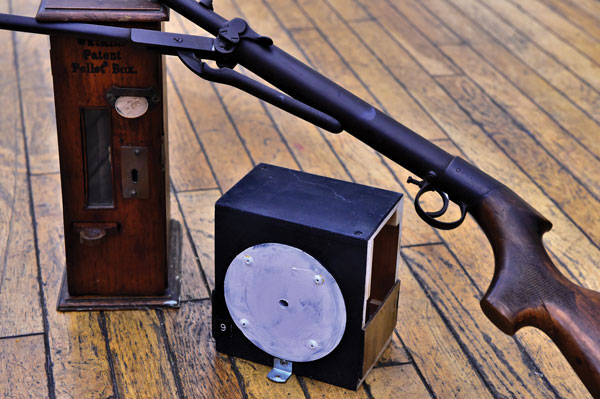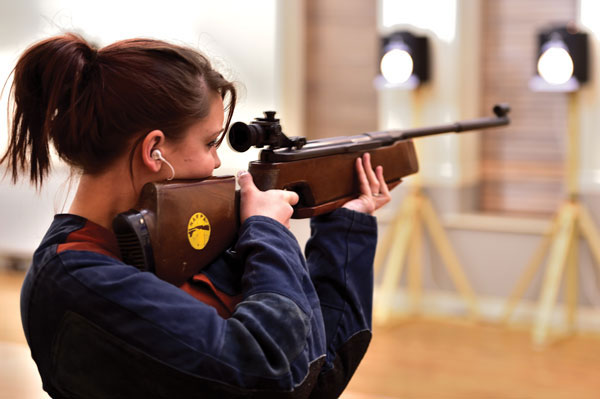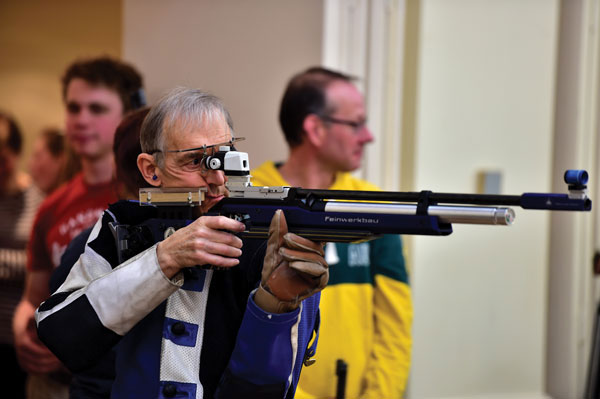
Bell Target Shooting
One of the world’s oldest target disciplines involves shooting at an extremely short range – but at an extremely small bullseye.
It was Henry VIII in the 1500s who first introduced compulsory shooting practice, with the law requiring all men under the age of 40 to fine-tune their archery skills with longbows. The king’s motive was to ensure England would have sufficient top-notch archers to mount an effective defence or to create a formidable army.
A similar policy was introduced by Queen Victoria following the Boer Wars, where the woeful standard of marksmanship within the British Army was exposed. She duly insisted that all able-bodied men learn to shoot well.
This directive proved to be the catalyst for organised bell target shooting. Prior to this royal decree, this discipline was merely an informal activity practised in the vicinity of Birmingham’s gunmaking quarter. However, it was immediately recognised as a suitable form of target practice designed to instil proficient marksmanship and adopted on a wider scale.
In 1903 bell target shooting was embraced by the National Rifle and Pistol Association and became a recognised competition discipline; indeed it was this competitive element that helped create the high level of marksmanship so desired.
A traditional pellet dispenser similar to those used in pubs, the bell target itself and a traditional vintage shotgun
It was also around this time, perhaps as a result of the growing interest in the activity, that Lincoln Jeffries revealed his innovative air rifle design. The gun proved suitable not just for bell target shooting – it was the most competitive rifle available. The reason for its success owed much to Jeffries’ use of a rifled barrel, the first air rifle maker to take this route. With his rivals still using smooth-bored airguns, Jeffries’ innovation gave him a distinct advantage.
After the Boer Wars the demand for military guns dropped overnight. One of these manufacturers, BSA, was seeking work for its factories and turned its tools and employees to making bicycles and motorcycles. Such had been the rapid rise of bell target shooting that BSA approached Jeffries to offer to build his air rifle under licence. A deal was struck and within 12 months BSA was churning out 10,000 air rifles a year. This dovetailed with the surge in interest of bell target shooting, and within two years of the activity falling under the auspices of the National Rifle and Pistol Association more than 4,000 bell target clubs had sprung up around the country, with 1,200 in Birmingham alone.
Most of these clubs were based in pubs, much like darts teams are today. The publican would supply a rifle and target for the use of members who would take alternate turns (working men couldn’t afford to buy their own in those days). Pellets were dispensed from a vending machine, a payment of 1d (one penny) procuring eight pellets – sufficient for two sighters, with the other six required for the competition.
Bell target shooting is a social actvity for people of all ages – with the added element of competition
.177 calibre rifles are a must-have, and scopes aren’t needed at all
The target itself consisted of a six-and-a-half-inch square steel plate housed in a box and set at a distance of six yards (18 feet). To ensure each shot could be seen the target plate was painted white. At the centre of the target was a three-eighths-inch hole which served as the bullseye, with scoring rings engraved around the bull at a space of one, two and three inches. Behind the hole sat a bell which rang with a clearly audible ‘ding’ each time it was struck. The hole circumference was significant as it represented the size of a typical man’s head at 100 yards – hence why bell target shooting proved useful for training civilians in wartime marksmanship. Incidentally, some pub teams shot over seven yards, although this was because they set up their bell targets using the premises’ skittle alley which happened to be seven yards long.
The target is scored after each detail. If the shooter gets a bull, the pellet will fly through the hole and ring the bell behind. Any pellet marks on the target are overpainted
Scoring
The target rings score 5, 4, 3, 2 and 0 (one-point scores are not included) A bell ring scores an extra 0.1. The score is taken from whichever ring contains the greater part of the pellet mark. In the case of an exact split the higher score is called.
Age and gender are no barrier for bell target shooting and most clubs have qualified coaches enabling children below legal age to be properly supervised and coached in the correct techniques.
Shooters stand behind the line as they take their shots
Many club shooters use supplied rifles illustrating how accessible a pastime, regardless of budget, bell target is. It’s a great leveller, too. Many competitors take part with affordable rifles, such as the Air Arms S200, while others shoot spring-powered rifles and are capable of holding their own against their precharged rivals. The Feinwerkbau is the rifle of choice for the top participants; the 800 series features very highly, but the 300 from the 1970s is still an extremely competitive gun even when pitted against the single-stroke pneumatic 600 series.
Bell target shooting promotes mental and personal discipline well into retirement
Rifles and sights
Depending on the league, rifle selection can be very much down to individual choice with everything from a 1903 Lincoln Jeffries, a springer, regular PCP or a modern match rifle such as a Feinwerkbau or Anschutz being used.
All rifles must be of .177 calibre.
The ideal power level is around 6 ft lb, the same standard power as match target rifles. This keeps pellet bounceback to a minimum – which is vital when shooting at a metal plate.
Aperture sights are the main preference but not acceptable in all leagues. Open post sights can work equally as well.
Scopes will not focus over such a short distance and are therefore useless.
Some leagues allow the use of lenses with aperture sights. Magnification will exaggerate movement making it harder to shoot but may correct an eye problem.
Shooting jackets, gloves and boots make a big difference by helping with posture, but these items are by no means a prerequisite and plenty of airgunners shoot in normal clothes and training shoes.
Bell target shooting is a discipline anyone can succeed at with the minimum of kit. However, a word of warning: once you try it, it can become very addictive.
It was Henry VIII in the 1500s who first introduced compulsory shooting practice, with the law requiring all men under the age of 40 to fine-tune their archery skills with longbows. The king’s motive was to ensure England would have sufficient top-notch archers to mount an effective defence or to create a formidable army.
A similar policy was introduced by Queen Victoria following the Boer Wars, where the woeful standard of marksmanship within the British Army was exposed. She duly insisted that all able-bodied men learn to shoot well.
This directive proved to be the catalyst for organised bell target shooting. Prior to this royal decree, this discipline was merely an informal activity practised in the vicinity of Birmingham’s gunmaking quarter. However, it was immediately recognised as a suitable form of target practice designed to instil proficient marksmanship and adopted on a wider scale.
In 1903 bell target shooting was embraced by the National Rifle and Pistol Association and became a recognised competition discipline; indeed it was this competitive element that helped create the high level of marksmanship so desired.
A traditional pellet dispenser similar to those used in pubs, the bell target itself and a traditional vintage shotgun
It was also around this time, perhaps as a result of the growing interest in the activity, that Lincoln Jeffries revealed his innovative air rifle design. The gun proved suitable not just for bell target shooting – it was the most competitive rifle available. The reason for its success owed much to Jeffries’ use of a rifled barrel, the first air rifle maker to take this route. With his rivals still using smooth-bored airguns, Jeffries’ innovation gave him a distinct advantage.
After the Boer Wars the demand for military guns dropped overnight. One of these manufacturers, BSA, was seeking work for its factories and turned its tools and employees to making bicycles and motorcycles. Such had been the rapid rise of bell target shooting that BSA approached Jeffries to offer to build his air rifle under licence. A deal was struck and within 12 months BSA was churning out 10,000 air rifles a year. This dovetailed with the surge in interest of bell target shooting, and within two years of the activity falling under the auspices of the National Rifle and Pistol Association more than 4,000 bell target clubs had sprung up around the country, with 1,200 in Birmingham alone.
Most of these clubs were based in pubs, much like darts teams are today. The publican would supply a rifle and target for the use of members who would take alternate turns (working men couldn’t afford to buy their own in those days). Pellets were dispensed from a vending machine, a payment of 1d (one penny) procuring eight pellets – sufficient for two sighters, with the other six required for the competition.
Bell target shooting is a social actvity for people of all ages – with the added element of competition
.177 calibre rifles are a must-have, and scopes aren’t needed at all
The target itself consisted of a six-and-a-half-inch square steel plate housed in a box and set at a distance of six yards (18 feet). To ensure each shot could be seen the target plate was painted white. At the centre of the target was a three-eighths-inch hole which served as the bullseye, with scoring rings engraved around the bull at a space of one, two and three inches. Behind the hole sat a bell which rang with a clearly audible ‘ding’ each time it was struck. The hole circumference was significant as it represented the size of a typical man’s head at 100 yards – hence why bell target shooting proved useful for training civilians in wartime marksmanship. Incidentally, some pub teams shot over seven yards, although this was because they set up their bell targets using the premises’ skittle alley which happened to be seven yards long.
The target is scored after each detail. If the shooter gets a bull, the pellet will fly through the hole and ring the bell behind. Any pellet marks on the target are overpainted
Scoring
The target rings score 5, 4, 3, 2 and 0 (one-point scores are not included) A bell ring scores an extra 0.1. The score is taken from whichever ring contains the greater part of the pellet mark. In the case of an exact split the higher score is called.
Age and gender are no barrier for bell target shooting and most clubs have qualified coaches enabling children below legal age to be properly supervised and coached in the correct techniques.
Shooters stand behind the line as they take their shots
Many club shooters use supplied rifles illustrating how accessible a pastime, regardless of budget, bell target is. It’s a great leveller, too. Many competitors take part with affordable rifles, such as the Air Arms S200, while others shoot spring-powered rifles and are capable of holding their own against their precharged rivals. The Feinwerkbau is the rifle of choice for the top participants; the 800 series features very highly, but the 300 from the 1970s is still an extremely competitive gun even when pitted against the single-stroke pneumatic 600 series.
Bell target shooting promotes mental and personal discipline well into retirement
Rifles and sights
Depending on the league, rifle selection can be very much down to individual choice with everything from a 1903 Lincoln Jeffries, a springer, regular PCP or a modern match rifle such as a Feinwerkbau or Anschutz being used.
All rifles must be of .177 calibre.
The ideal power level is around 6 ft lb, the same standard power as match target rifles. This keeps pellet bounceback to a minimum – which is vital when shooting at a metal plate.
Aperture sights are the main preference but not acceptable in all leagues. Open post sights can work equally as well.
Scopes will not focus over such a short distance and are therefore useless.
Some leagues allow the use of lenses with aperture sights. Magnification will exaggerate movement making it harder to shoot but may correct an eye problem.
Shooting jackets, gloves and boots make a big difference by helping with posture, but these items are by no means a prerequisite and plenty of airgunners shoot in normal clothes and training shoes.
Bell target shooting is a discipline anyone can succeed at with the minimum of kit. However, a word of warning: once you try it, it can become very addictive.
Text and images from: Airgun and Shooter

Bell target shooting has enjoyed a revival lately, and it’s easy to see why

A traditional pellet dispenser similar to those used in pubs, the bell target itself and a traditional vintage air rifle

Bell target shooting is a social actvity for people of all ages – with the added element of competition

Bell target shooting promotes mental and personal discipline well into retirement